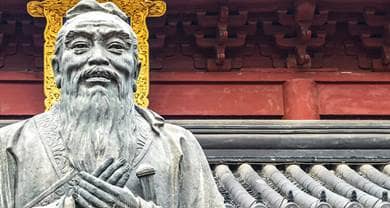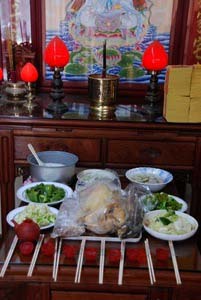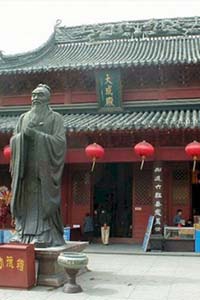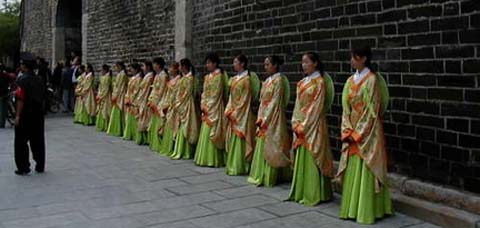- Trending:
- Pope Leo Xiv
- |
- Israel
- |
- Trump
- |
- Social Justice
- |
- Peace
- |
- Love

RELIGION LIBRARY
Confucianism
Sacred Space
Kongzi stated that divine realms are beyond human comprehension, so there is no Confucian concept of a sacred space outside of the realm of life on earth. The focus of Confucianism is ordinary human interactions, and thus, in a sense, the ordinary space of daily life becomes sacred space.
The most sacred space for Confucians may also be the most ordinary: the family home. In the home, the generations meet under one roof and help one another along on the path toward spiritual self-transformation. Elders fulfill their obligation to their ancestors by guiding the young and sharing wisdom handed down to them, ultimately becoming ancestors themselves. Youth fulfill their obligation to their elders by accepting guidance and seeking out the wisdom of the aged, maintaining their relationship with their forebears beyond the grave through ancestor worship.
 Although ancestor worship may take place in public venues, such as community temples or public cemeteries, most ancestor worship takes place in the home at a domestic altar or in a family temple, where the name plaques or tablets drawn from family genealogical tables are kept. Offerings of incense, cooked rice, or fresh fruit are made to ancestors who remain within living memory -- usually only those of the last two or three generations. Over time, as ancestors recede from the consciousness of the living, their name plaques or tablets are ritually burned, while others take their place. Despite their eventual disappearance from family altars, remote ancestors' names usually are retained in carefully-kept family records.
Although ancestor worship may take place in public venues, such as community temples or public cemeteries, most ancestor worship takes place in the home at a domestic altar or in a family temple, where the name plaques or tablets drawn from family genealogical tables are kept. Offerings of incense, cooked rice, or fresh fruit are made to ancestors who remain within living memory -- usually only those of the last two or three generations. Over time, as ancestors recede from the consciousness of the living, their name plaques or tablets are ritually burned, while others take their place. Despite their eventual disappearance from family altars, remote ancestors' names usually are retained in carefully-kept family records.
 In pre-modern East Asia, the academies maintained by Confucian scholars functioned as sacred spaces. Here, young men would prepare for the competitive civil service examinations that served as the gateway to a successful career as a government official, and which were based on knowledge of Confucian scriptures and their orthodox interpretations and commentaries. Such Confucian academies once could be found all over China as well as in Vietnam, Korea, and Japan. Although Confucian learning ceased to be the basis of service in government after the fall of China's Qing dynasty in 1911, recently there have been efforts to revive elements of the traditional Confucian curriculum at all levels of Chinese educational institutions, from elementary schools to universities. In South Korea and Japan, high school students still study basic Confucian texts such as the Lunyu, and the educational systems of both countries still reflect Confucian concerns for moral development as an integral part of all learning, as well as the Confucian conviction that one should win a place in society based on one's merit and attainment, rather than by birth or wealth. Recently, there have been attempts to revive the Confucian academy by "New Confucian" intellectuals, who see a need for such an institution in present-day China.
In pre-modern East Asia, the academies maintained by Confucian scholars functioned as sacred spaces. Here, young men would prepare for the competitive civil service examinations that served as the gateway to a successful career as a government official, and which were based on knowledge of Confucian scriptures and their orthodox interpretations and commentaries. Such Confucian academies once could be found all over China as well as in Vietnam, Korea, and Japan. Although Confucian learning ceased to be the basis of service in government after the fall of China's Qing dynasty in 1911, recently there have been efforts to revive elements of the traditional Confucian curriculum at all levels of Chinese educational institutions, from elementary schools to universities. In South Korea and Japan, high school students still study basic Confucian texts such as the Lunyu, and the educational systems of both countries still reflect Confucian concerns for moral development as an integral part of all learning, as well as the Confucian conviction that one should win a place in society based on one's merit and attainment, rather than by birth or wealth. Recently, there have been attempts to revive the Confucian academy by "New Confucian" intellectuals, who see a need for such an institution in present-day China.

Confucian academies often were established on the grounds of Kongmiao (temples to Kongzi), first erected by government decree during the Han dynasty (202 B.C.E.-220 C.E.) and sporadically thereafter by subsequent dynasties. Between the Han and the Ming (1368-1644) dynasties, the alleged home of Kongzi in Qufu, Shandong province, was renovated on several occasions to serve as a temple in his honor, and today the building is second in size only to Beijing's "Forbidden City" (the former Ming and Qing dynastes' imperial palace) among China's historical properties. At this and other Confucian temples, members of the Kong family -- descendants of Kongzi (the foremost of which fled mainland China in the 1940s to settle in Taiwan) -- enjoyed the hereditary privilege of maintaining temple grounds and presiding over temple rituals.
Temples featured a collection of sculptures or paintings depicting Kongzi and various other Confucian saints, as well as altars at which Kongzi, other members of the Kong family, and notables such as Mengzi (372-289 B.C.E.) and Zhu Xi (1130-1200 C.E.), were offered sacrifices, much as in ancestor worship. Apart from China (including Taiwan), the country with the largest number of Confucian temples is South Korea, although several still exist in Vietnam and Japan as well as in Indonesia and Malaysia. These are the preeminent sites on which Kongzi's birthday (September 28) is commemorated, but most function as community libraries, venues for traditional arts, and gathering places for the elderly when not in formal ritual use.
Sacrifices to Kongzi and other Confucian saints were only part of a nationwide ritual system, at the pinnacle of which was the worship of Tian (Heaven) carried out by the Chinese emperor (who traditionally called himself Tianzi, "son of Heaven"). During the Ming and Qing dynasties, imperial sacrifices to Tian for the sake of assuring good harvests were performed at the Tiantan (Altar of Heaven) in southeastern Beijing, which is quite possibly the most dramatic Confucian sacred space in China apart from the Confucian temple in Qufu. Originally constructed in the 15th century by the Ming emperors, it later became the site of the former Qing dynasty general Yuan Shikai's dramatic attempt to claim imperial power by worshipping Tian in a Ming dynasty-style ritual there.
Study Questions:
1. What private spaces are most sacred to Confucians?
2. What public spaces are most sacred to Confucians?
3. What might one encounter in a Confucian temple?










